Development of Wearable Wireless Multichannel f-NIRS System to Evaluate Activities
Abstract
1. Introduction
2. System Design and Methods
2.1. Hardware of fNIRS System
2.2. Data Acquisition with Dual-NIRS Light
2.3. System Implementation
3. Experiments and Results
3.1. System Reliability Verification and SNR Testing
3.2. Data Acquisition with Dual-NIRS Light
3.3. Bandage Masking Experiment
3.4. MA Experiment
4. Discussion
5. Conclusions
Author Contributions
Funding
Data Availability Statement
Conflicts of Interest
References
- Fang, J.; Yan, D.; Qiao, J.; Xue, J.; Yu, H. DADA: Driver attention prediction in driving accident scenarios. IEEE Trans. Intell. Transp. Syst. 2021, 23, 4959–4971. [Google Scholar] [CrossRef]
- Yang, Q.; Cruz-Garza, J.G.; Kalantari, S. Brain–computer interfaces as an architectural design tool: Feasibility and usability study. Autom. Constr. 2023, 154, 105011. [Google Scholar] [CrossRef]
- He, B.; Yuan, H.; Meng, J.; Gao, S. Brain–computer interfaces. Neural Eng. 2020, 131–183. [Google Scholar] [CrossRef]
- Boas, D.A.; Elwell, C.E.; Ferrari, M.; Taga, G. Twenty years of functional near-infrared spectroscopy: Introduction for the special issue. Neuroimage 2014, 85, 1–5. [Google Scholar] [CrossRef]
- Jue, T.; Masuda, K. Application of Near Infrared Spectroscopy in Biomedicine; Springer: Berlin/Heidelberg, Germany, 2013. [Google Scholar]
- Toronov, V.; Franceschini, M.A.; Filiaci, M.; Fantini, S.; Wolf, M.; Michalos, A.; Gratton, E. Near-infrared study of fluctuations in cerebral hemodynamics during rest and motor stimulation: Temporal analysis and spatial mapping. Med. Phys. 2000, 27, 801–815. [Google Scholar] [CrossRef]
- Fantini, S.; Frederick, B.; Sassaroli, A. Perspective: Prospects of non-invasive sensing of the human brain with diffuse optical imaging. Apl Photonics 2018, 3, 110901. [Google Scholar] [CrossRef]
- Jobsis, F.F. Noninvasive, Infrared Monitoring of Cerebral and Myocardial Oxygen Sufficiency and Circulatory Parameters. Science 1977, 198, 1264–1267. [Google Scholar] [CrossRef]
- Von Luehmann, A.; Boukouvalas, Z.; Mueller, K.R.; Adali, T. A New Blind Source Separation Framework for Signal Analysis and Artifact Rejection in Functional Near-Infrared Spectroscopy. Neuroimage 2019, 200, 72–88. [Google Scholar] [CrossRef]
- Kocsis, L.; Herman, P.; Eke, A. The Modified Beer-Lambert Law Revisited. Phys. Med. Biol. 2006, 51, N91–N98. [Google Scholar] [CrossRef]
- Almulla, L.; Al-Naib, I.; Althobaiti, M. Hemodynamic responses during standing and sitting activities: A study toward fNIRS-BCI. Biomed. Phys. Eng. Express 2020, 6, 055005. [Google Scholar] [CrossRef]
- Cicalese, P.A.; Li, R.; Ahmadi, M.B.; Wang, C.; Francis, J.T.; Selvaraj, S.; Schulz, P.E.; Zhang, Y. An EEG-fNIRS hybridization technique in the four-class classification of alzheimer’s disease. J. Neurosci. Methods 2020, 336, 108618. [Google Scholar] [CrossRef] [PubMed]
- Yücel, M.A.; Lühmann, A.v.; Scholkmann, F.; Gervain, J.; Dan, I.; Ayaz, H.; Boas, D.; Cooper, R.J.; Culver, J.; Elwell, C.E.; et al. Best practices for fNIRS publications. Neurophotonics 2021, 8, 012101. [Google Scholar] [CrossRef] [PubMed]
- Eastmond, C.; Subedi, A.; De, S.; Intes, X. Deep learning in fNIRS: A review. Neurophotonics 2022, 9, 041411. [Google Scholar] [CrossRef] [PubMed]
- Oshina, I.; Spigulis, J. Beer–Lambert law for optical tissue diagnostics: Current state of the art and the main limitations. J. Biomed. Opt. 2021, 26, 100901. [Google Scholar] [CrossRef]
- Ferrier, D.; Yeo, G.F. XIX. A record of experiments on the effects of lesion of different regions of the cerebral hemispheres. Philos. Trans. R. Soc. Lond. 1884, 175, 479–564. [Google Scholar]
- Brodmann, K. Vergleichende Lokalisationslehre der Grosshirnrinde in ihren Prinzipien dargestellt auf Grund des Zellenbaues; Leipzig: Barth, Germany, 1909. [Google Scholar]
- Fan, S.; Blanco-Davis, E.; Zhang, J.; Bury, A.; Warren, J.; Yang, Z.; Yan, X.; Wang, J.; Fairclough, S. The role of the prefrontal cortex and functional connectivity during maritime operations: An fNIRS study. Brain Behav. 2021, 11, e01910. [Google Scholar] [CrossRef]
- Xiao, T.; Xiao, Z.; Ke, X.; Hong, S.; Yang, H.; Su, Y.; Chu, K.; Xiao, X.; Shen, J.; Liu, Y. Response inhibition impairment in high functioning autism and attention deficit hyperactivity disorder: Evidence from near-infrared spectroscopy data. PLoS ONE 2012, 7, e46569. [Google Scholar] [CrossRef]
- Ikeda, T.; Tokuda, T.; Monden, Y.; Hirai, M.; Mizushima, S.G.; Nagashima, M.; Kyutoku, Y.; Taniguchi, T.; Shimoizumi, H.; Dan, I.; et al. Hypoactivation of the right prefrontal cortex underlying motor-related inhibitory deficits in children with autism spectrum disorder: A functional near-infrared spectroscopy study. Jpn. Psychol. Res. 2018, 60, 251–264. [Google Scholar] [CrossRef]
- Shin, J.; Kwon, J.; Im, C.H. A ternary hybrid EEG-NIRS brain-computer interface for the classification of brain activation patterns during mental arithmetic, motor imagery, and idle state. Front. Neuroinform. 2018, 12, 5. [Google Scholar] [CrossRef]
- Bracken, B.K.; Houssan, C.; Broach, J.; Milsten, A.; Leather, C.; Tobyne, S.; Winder, A.; Farry, M. Evaluation of a New Functional near Infrared Spectroscopy (fNIRS) Sensor, the fNIRS Explorer™, and Software to Assess Cognitive Workload during Ecologically Valid Tasks. In Proceedings of the BIOSIGNALS, 13th International Conference on Bio-Inspired Systems and Signal Processing, Valetta, Malta, 24–26 February 2020; pp. 179–186. [Google Scholar]
- Althobaiti, M.; Al-Naib, I. Recent developments in instrumentation of functional near-infrared spectroscopy systems. Appl. Sci. 2020, 10, 6522. [Google Scholar] [CrossRef]
- Chhabra, H.; Shajil, N.; Venkatasubramanian, G. Investigation of deep convolutional neural network for classification of motor imagery fNIRS signals for BCI applications. Biomed. Signal Process. Control 2020, 62, 102133. [Google Scholar]
- Hoshi, Y. Hemodynamic signals in fNIRS. Prog. Brain Res. 2016, 225, 153–179. [Google Scholar]
- Matcher, S.; Elwell, C.; Cooper, C.; Cope, M.; Delpy, D. Performance comparison of several published tissue near-infrared spectroscopy algorithms. Anal. Biochem. 1995, 227, 54–68. [Google Scholar] [CrossRef]
- Duncan, A.; Meek, J.H.; Clemence, M.; Elwell, C.E.; Tyszczuk, L.; Cope, M.; Delpy, D. Optical pathlength measurements on adult head, calf and forearm and the head of the newborn infant using phase resolved optical spectroscopy. Phys. Med. Biol. 1995, 40, 295. [Google Scholar] [CrossRef]
- Bognár, J. Indefinite Inner Product Spaces; Springer Science & Business Media: Berlin/Heidelberg, Germany, 2012; Volume 78. [Google Scholar]
- Cui, X.; Bray, S.; Reiss, A.L. Functional near infrared spectroscopy (NIRS) signal improvement based on negative correlation between oxygenated and deoxygenated hemoglobin dynamics. Neuroimage 2010, 49, 3039–3046. [Google Scholar] [CrossRef]
- Fishburn, F.A.; Ludlum, R.S.; Vaidya, C.J.; Medvedev, A.V. Temporal derivative distribution repair (TDDR): A motion correction method for fNIRS. Neuroimage 2019, 184, 171–179. [Google Scholar] [CrossRef]
- Muehlemann, T.; Haensse, D.; Wolf, M. Wireless miniaturized in-vivo near infrared imaging. Opt. Express 2008, 16, 10323–10330. [Google Scholar] [CrossRef]
- Guo, W.; Sheng, X.; Liu, H.; Zhu, X. Development of a multi-channel compact-size wireless hybrid sEMG/NIRS sensor system for prosthetic manipulation. IEEE Sens. J. 2015, 16, 447–456. [Google Scholar] [CrossRef]
- Everdell, N.; Airantzis, D.; Kolvya, C.; Suzuki, T.; Elwell, C. A portable wireless near-infrared spatially resolved spectroscopy system for use on brain and muscle. Med. Eng. Phys. 2013, 35, 1692–1697. [Google Scholar] [CrossRef]
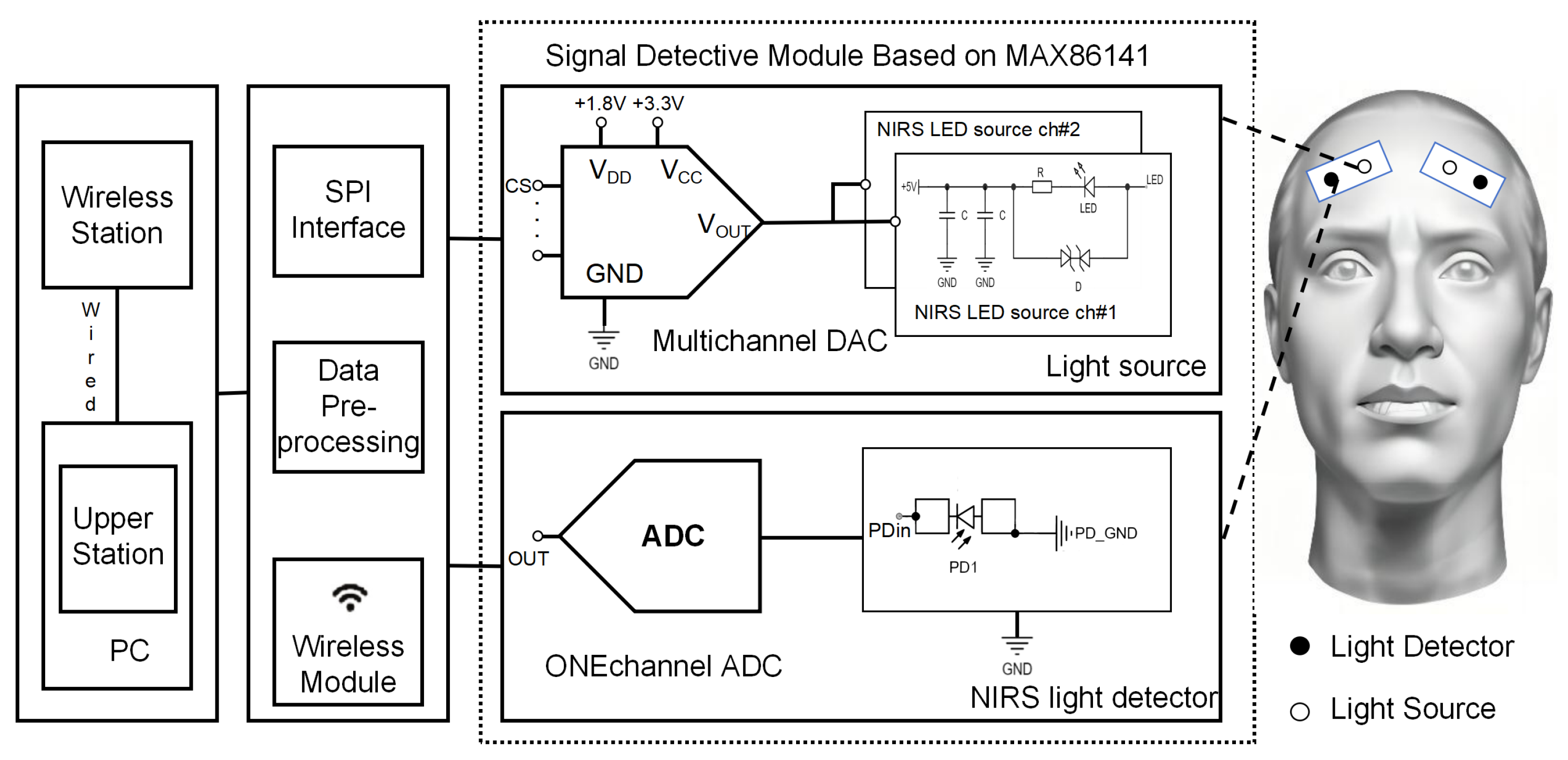
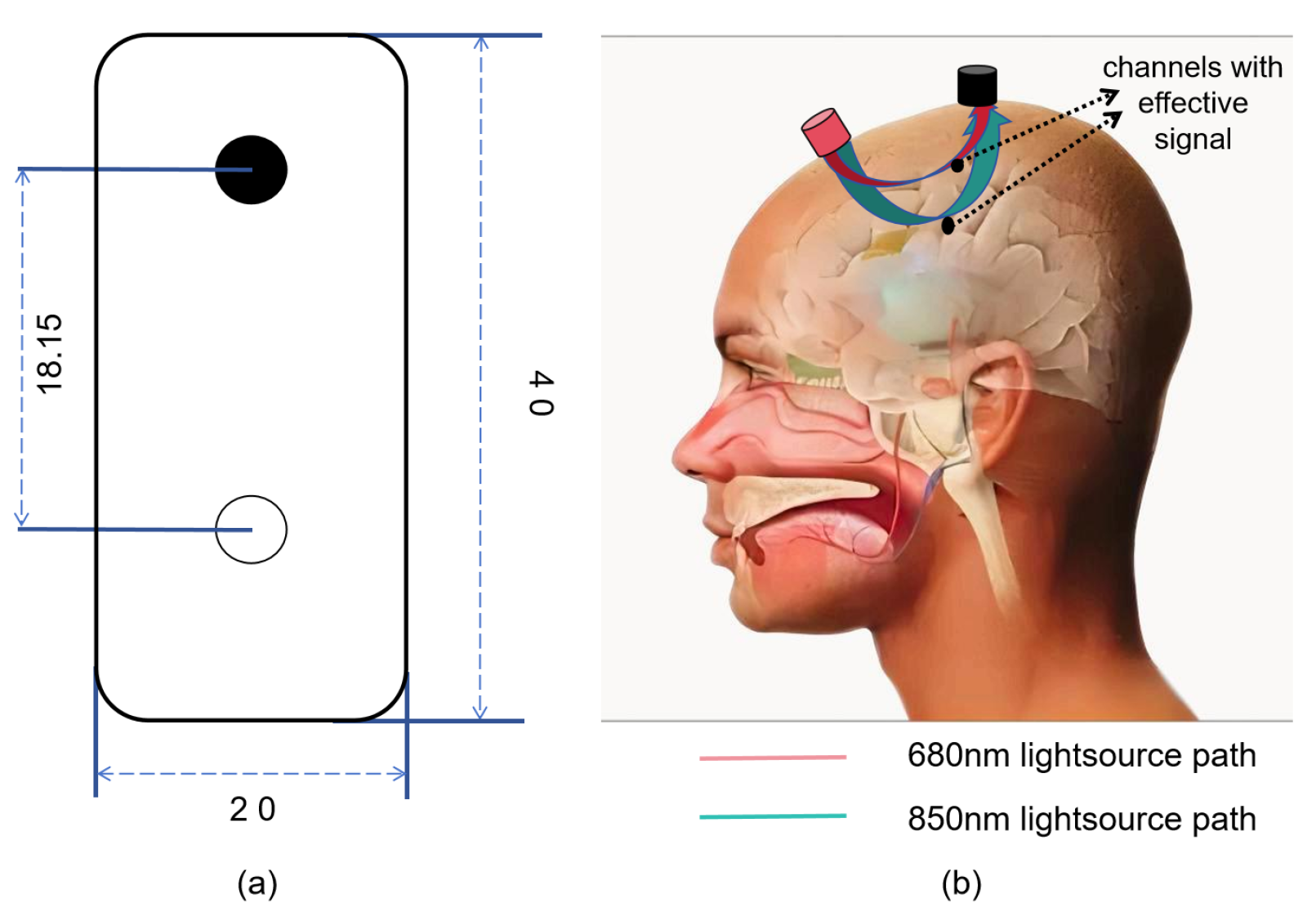
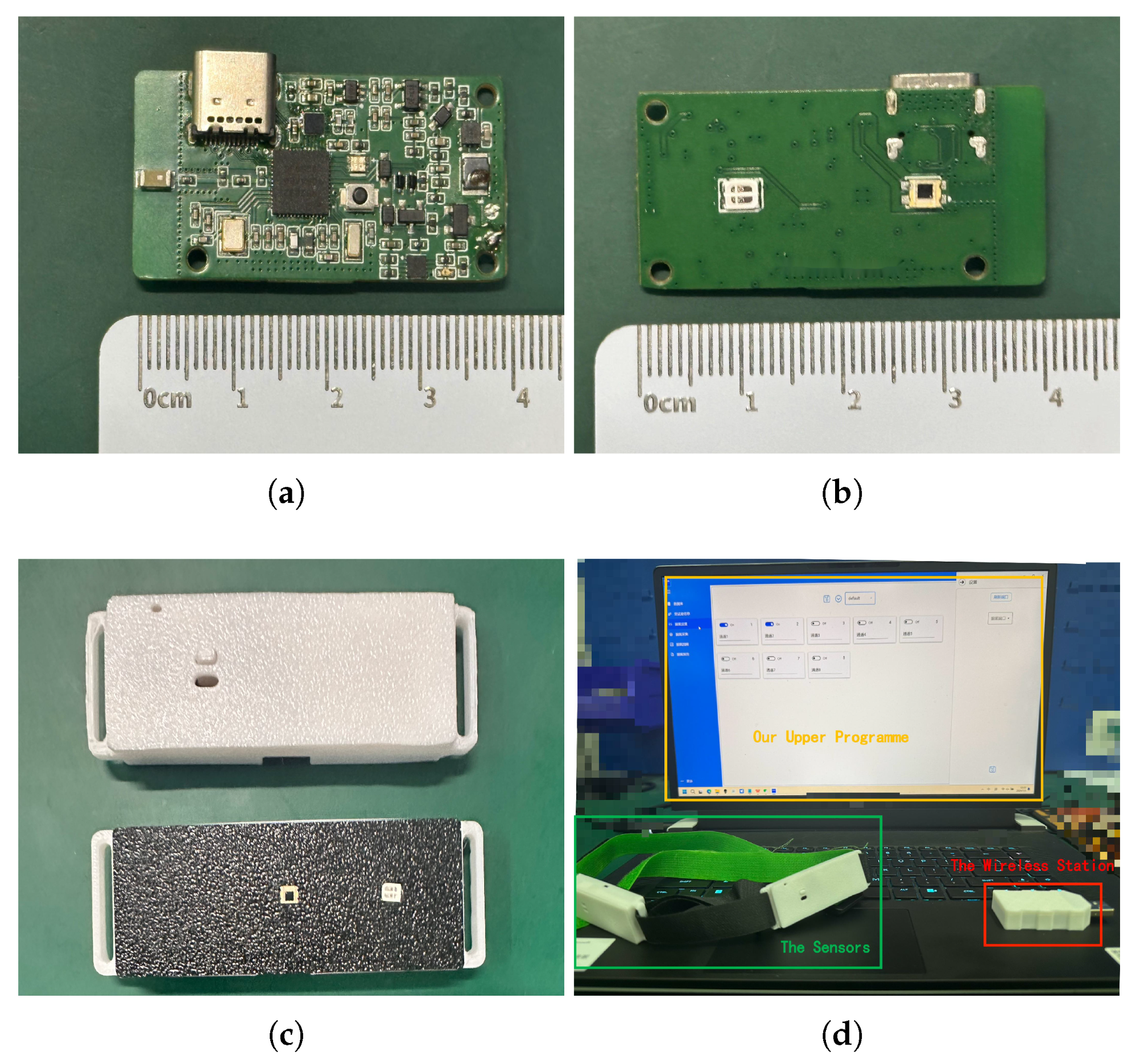
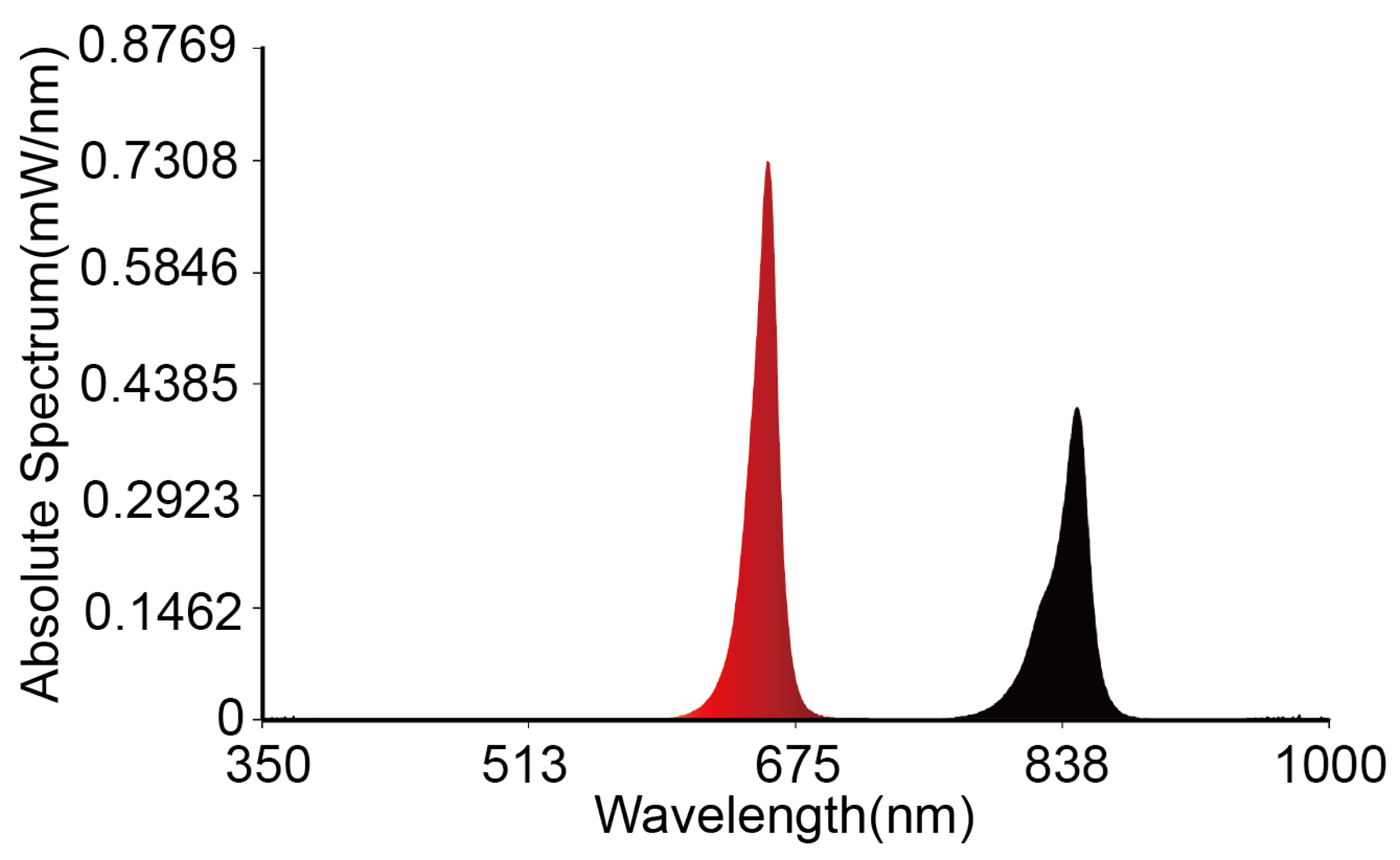
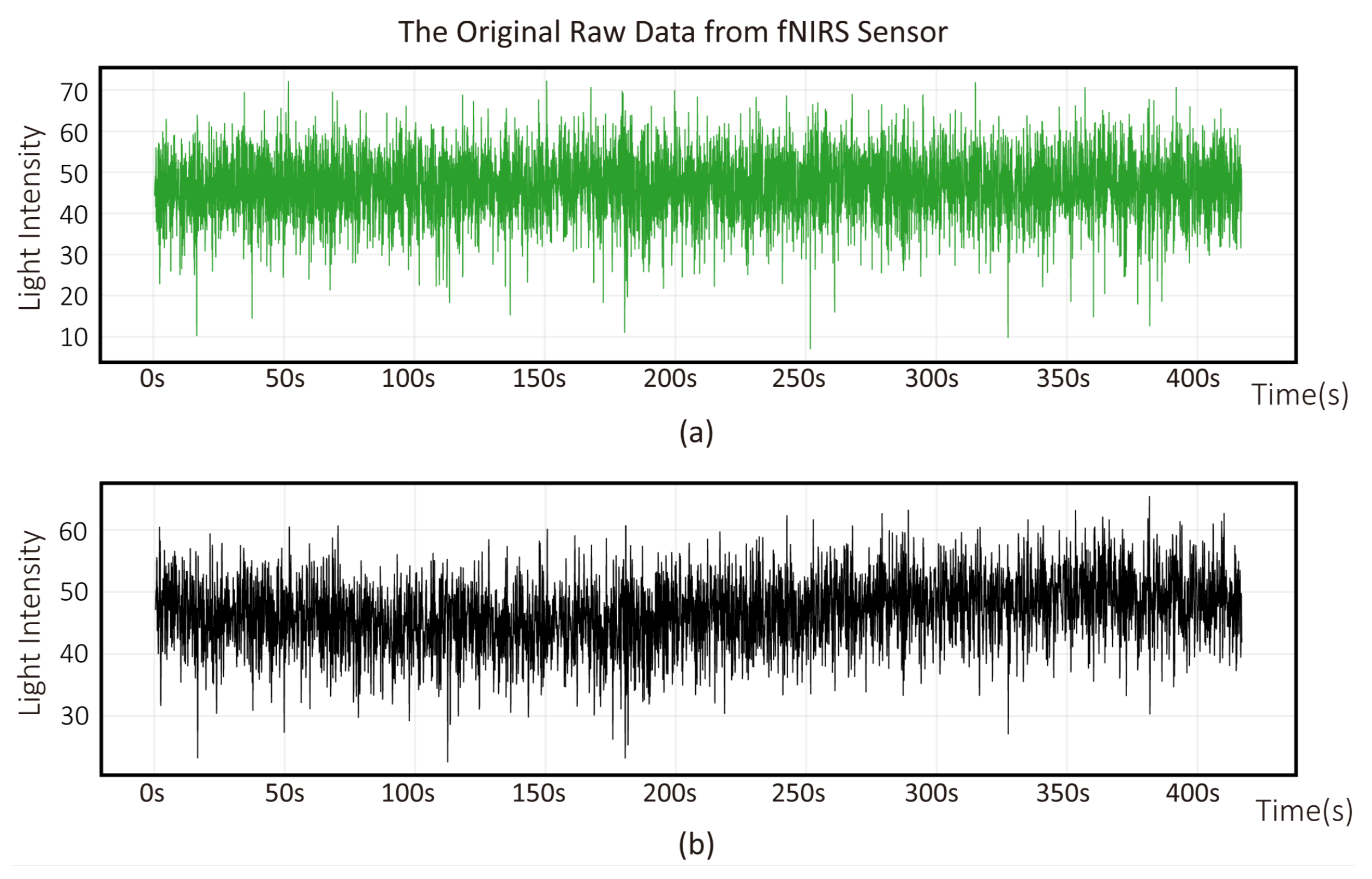
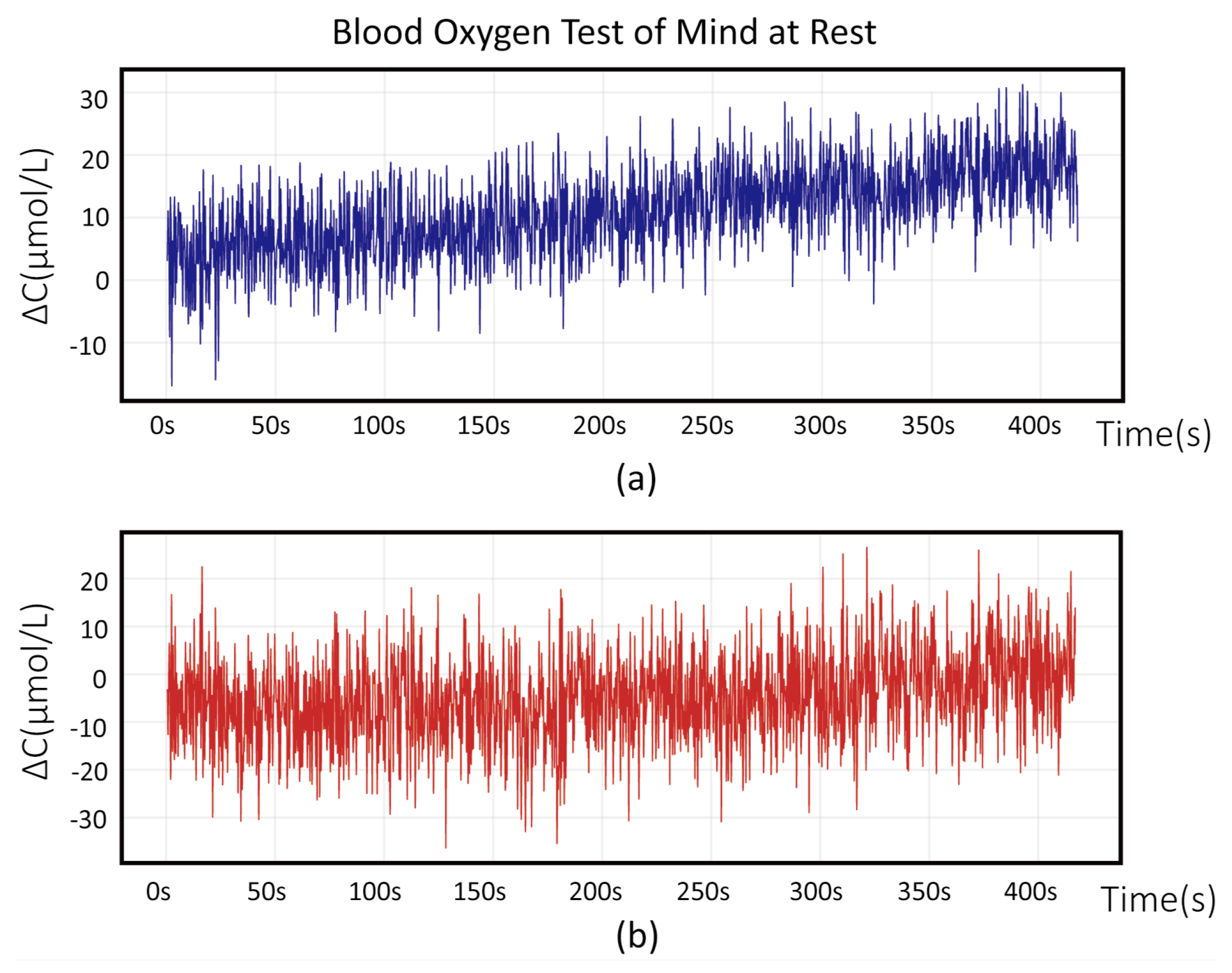
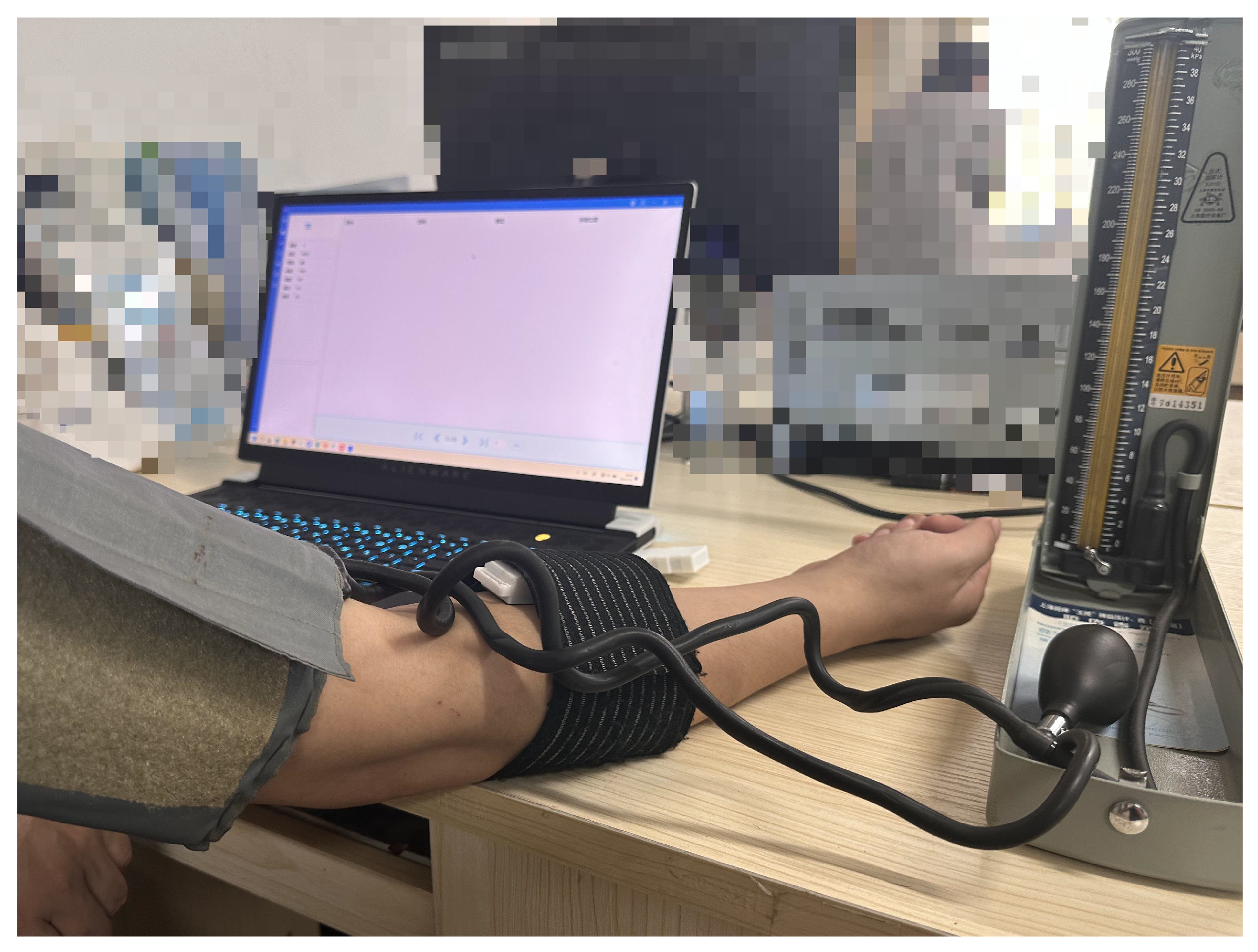
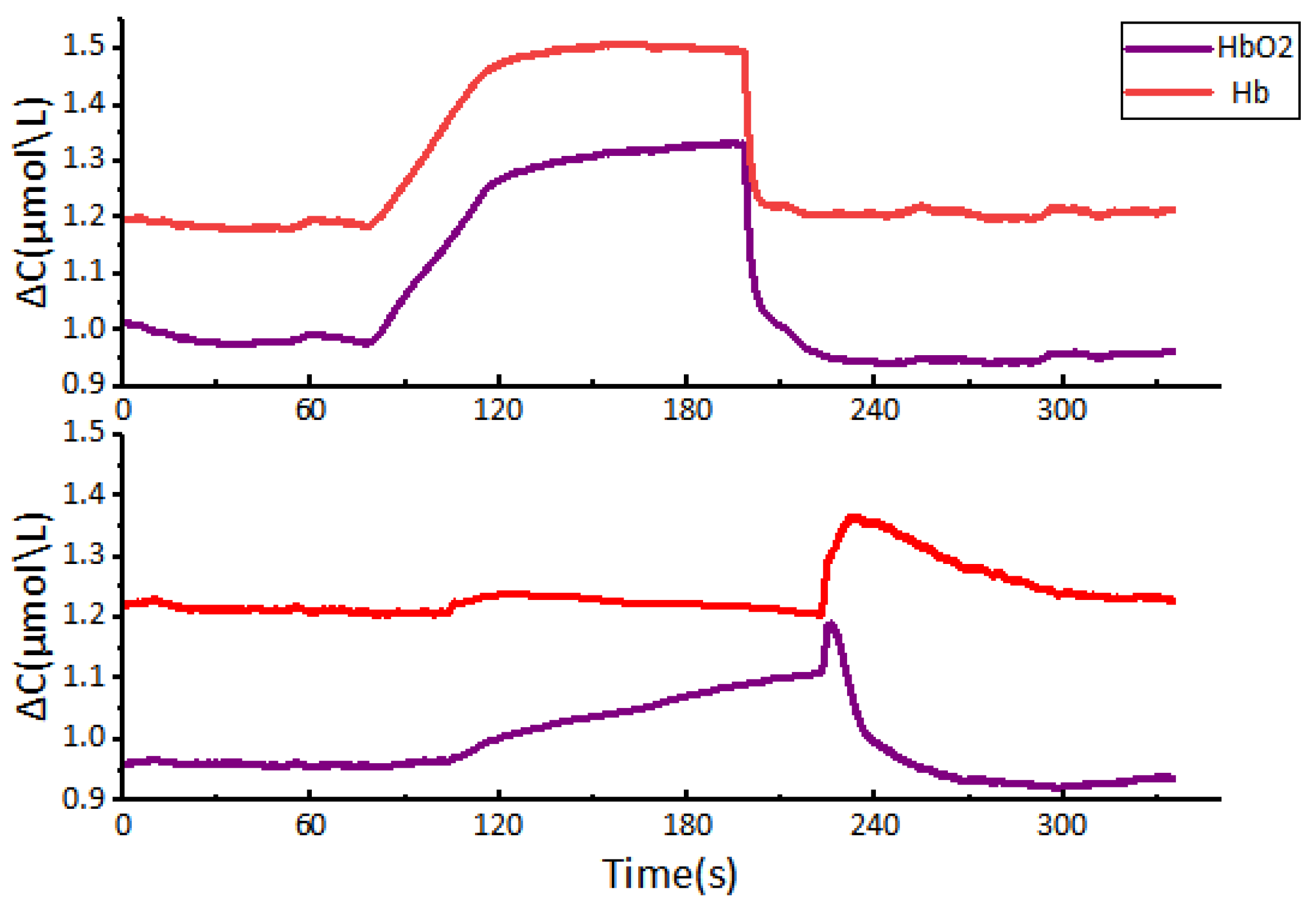
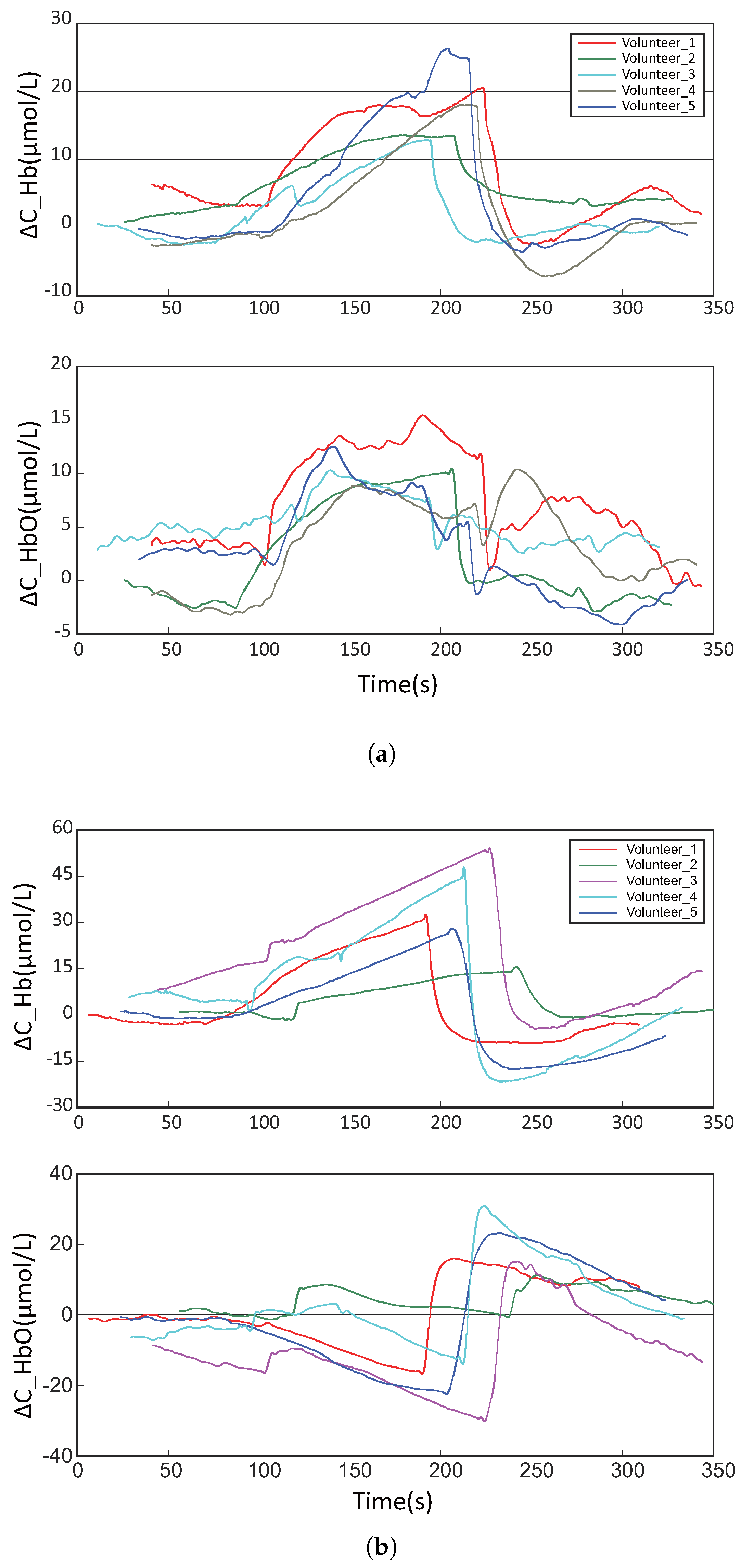


| Subject | Gender (M/F) | Age (y) | Height (cm) | Weight (kg) | Systolic (mmHg) | Diastolic (mmHg) |
|---|---|---|---|---|---|---|
| S0 | M | 26 | 172 | 65 | 125 | 77 |
| S1 | M | 26 | 199 | 108 | 121 | 80 |
| S2 | M | 30 | 170 | 90 | 144 | 119 |
| S3 | F | 24 | 173 | 78 | 122 | 76 |
| S4 | M | 27 | 170 | 68 | 108 | 71 |
| S5 | M | 27 | 172 | 81 | 101 | 70 |
| Hb Max | Hb Min | Hb Avg | HbO Max | HbO Min | HbO Avg | |
|---|---|---|---|---|---|---|
| REST PART I | 18.73 | 7.71 | 13.86 | −32.70 | −45.95 | −38.65 |
| TASK PART | 30.96 | 4.73 | 22.64 | −13.48 | −42.82 | −26.71 |
| REST PART II | 11.62 | 4.96 | 8.02 | −24.04 | −42.95 | −32.84 |
| Hb Max | Hb Min | Hb Avg | HbO Max | HbO Min | HbO Avg | |
|---|---|---|---|---|---|---|
| REST PART I | 8.22 | −5.72 | 1.49 | −1.91 | −24.18 | −13.26 |
| TASK PART | 12.65 | −10.71 | 5.33 | −2.42 | −41.32 | −21.78 |
| REST PART II | −3.40 | −12.05 | −6.82 | −3.17 | −20.22 | −10.08 |
| Our Work | Paper [32] | Paper [31] | Paper [33] | |
|---|---|---|---|---|
| Wavlength (nm) | 660, 850 | 730, 805, 850 | 760, 870 | 775, 810, 850 |
| Detector Number | 1 | 1 | 2 | 4 |
| SD Distance (mm) | 18.15 | 25 | 40 | 25 |
| Sampling Rate (Hz) | 16 | 1000 | 100 | 10 |
| ADC Resolution | 19 | 16 | 12 | 12 |
| Battery Life (h) | 4.5 | 4 | 4 | 1 |
| Channel Number | 8 | 4 | 4 | 1 |
| SNR (dB) | 58 | 66 | 37 | 49 |
Disclaimer/Publisher’s Note: The statements, opinions and data contained in all publications are solely those of the individual author(s) and contributor(s) and not of MDPI and/or the editor(s). MDPI and/or the editor(s) disclaim responsibility for any injury to people or property resulting from any ideas, methods, instructions or products referred to in the content. |
© 2025 by the authors. Licensee MDPI, Basel, Switzerland. This article is an open access article distributed under the terms and conditions of the Creative Commons Attribution (CC BY) license (https://creativecommons.org/licenses/by/4.0/).
Share and Cite
Ma, X.; Miao, T.; Xie, F.; Zhang, J.; Zheng, L.; Liu, X.; Hai, H. Development of Wearable Wireless Multichannel f-NIRS System to Evaluate Activities. Micromachines 2025, 16, 576. https://doi.org/10.3390/mi16050576
Ma X, Miao T, Xie F, Zhang J, Zheng L, Liu X, Hai H. Development of Wearable Wireless Multichannel f-NIRS System to Evaluate Activities. Micromachines. 2025; 16(5):576. https://doi.org/10.3390/mi16050576
Chicago/Turabian StyleMa, Xiaojie, Tianchao Miao, Fawen Xie, Jieyu Zhang, Lulu Zheng, Xiang Liu, and Hangrui Hai. 2025. "Development of Wearable Wireless Multichannel f-NIRS System to Evaluate Activities" Micromachines 16, no. 5: 576. https://doi.org/10.3390/mi16050576
APA StyleMa, X., Miao, T., Xie, F., Zhang, J., Zheng, L., Liu, X., & Hai, H. (2025). Development of Wearable Wireless Multichannel f-NIRS System to Evaluate Activities. Micromachines, 16(5), 576. https://doi.org/10.3390/mi16050576






